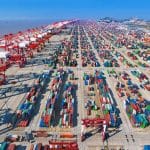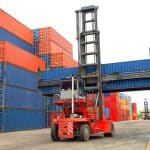PORT OF LONG BEACH DREDGING PROJECTS APPROVED
Officials at the Port of Long Beach, one of the busiest ports in the nation, have approved a $170 million channel deepening project that will improve navigation and safety for bigger vessels. Following an extensive environmental review process, the Long Beach Harbour Commission has now greenlit the project, which will also allow the port to welcome newer and more efficient ships. “By improving navigation in Long Beach Harbour, goods will speed faster around the supply chain, yielding enormous economic benefits for our city, region, and the nation,” said Harbour Commission President Sharon L. Weissman. “At the same time, it will make operations safer and help lessen environmental impacts on our community.
“The Port of Long Beach and the federal government will share in the costs of the project, estimated at almost $170 million. The port’s portion is estimated at $109 million. Among other features, the project includes deepening the Long Beach Approach Channel from 76 feet to 80 feet deep, easing turning bends in the Main Channel to deepen a wider area to 76 feet, deepening parts of the West Basin from 50 to 55 feet, constructing an approach channel and turning basin to Pier J South with a depth of 55 feet, improving the breakwaters at the entrance to Pier J, and depositing dredged material in nearshore sites for refuse or in federally approved ocean disposal sites. According to a multi-year federal study conducted by the U.S. Army Corps of Engineers and completed last October, deepening and widening channels in the harbour would lead to improved vessel navigation, safety, and national economic benefits of almost $21 million annually.
US UNIONS WORK TO AVOID RAIL STRIKES
Freight railroads and labour unions are working through the weekend to hammer out a new contract to avoid a strike that could snarl supply chains, disrupt agricultural deliveries and cost the US economy more than $2 billion a day. Railroads have advised customers of some potential service disruptions starting on Monday if talks don’t progress ahead of a potential walkout on Sept. 17. Six Class I freight railroads will begin to take steps to “manage and secure” shipments of some hazardous or sensitive materials starting Monday, Railroads will continue meeting throughout the weekend with the remaining unions to work toward tentative agreements.
“The railroads want, and continue to advocate for, a prompt resolution that would provide historic wage increases to rail employees – and allow the railroads to continue servicing customers and prevent further disruption to the struggling supply chain. “With freight railroads serving agricultural, industrial, wholesale, retail and other parts of the US economy, a nationwide shutdown could cost up to $2 billion a day, the group predicts. At a time of elevated inflation, the stoppage could result in plant shutdowns, lost jobs and higher costs for consumers and businesses.
CHALLENGING NEGOTIATIONS
Railroads and workers have faced years of challenging negotiations, which began in January 2020, shortly after the labour contract froze at 2019 levels. After the National Mediation Board failed to carve out an agreement earlier this summer, the Biden administration appointed a team that issued recommendations including wage increases and expanded health coverage.
While 10 of 12 railroad workers’ unions have struck new labour deals, the two holdouts — the Brotherhood of Locomotive Engineers and Trainmen and the International Association of Sheet Metal Air, Rail, and Transportation Workers — account for more than 90,000 rail employees. The two union groups have said they “remain committed” to negotiating a contract that meets the most important demands of its members, including wages and time off. A freight rail shutdown ahead of the midterm elections could also carry a political risk for President Joe Biden and the Democrats as they struggle to rebuild their historic ties with union and blue-collar voters.
PORT OF SAVANNAH REPORTS BUSIEST MONTH ON RECORD IN AUGUST
The Georgia Ports Authority said it handled 575,513 TEU in August making for its busiest month ever. The figure represents a whopping 18.5% increase compared to the same month in 2021, representing a 89,918 TEU jump. Savannah has been picking up cargo volumes diverted from West Coast ports that have experienced congestion
throughout the pandemic and threats of labour action as the ILWU and PMA continue to negotiate a new contract for more 22,000 West Coast port workers. “The Port of Savannah’s geographic and capacity advantages remain a driving force behind current and new customers deciding to move cargo through Georgia,” said GPA Executive Director Griff
Lynch. “Our central location, and service through the largest container terminal in the Western Hemisphere offers speed to market and unmatched room to grow. “Combined with July’s 530,800 TEUs, the Port of Savannah has now cleared the 1 million-TEU mark in a fiscal year—it’s fastest pace on record. August’s Intermodal volumes, including operations at Garden City Terminal and the Appalachian Regional Port, totalled nearly 51,700 rail lifts in August, up by more than 4,000 lifts compared to the same month last year.
CAPACITY EXPANSION
While the Port of Savannah continues to work through a vessel backlog, Lynch noted imports on the water are trending downward compared to July, when there were 265,000 containers destined for Savannah. That number has been decreased to 223,460 boxes on the water currently. The Georgia Ports Authority website shows 37 containerships waiting at anchor, which is down from more than 40 earlier this year but still way above normal pre-pandemic levels.
The number of vessels at anchor will dwindle over the next six weeks, and a more permanent solution will come online in June 2023, when improvements to Container Berth 1 at Garden City Terminal are completed. That project, now more than 60 percent complete, will provide space for a fourth big ship berth, allowing the Port of Savannah to simultaneously serve four 16,000-TEU vessels, as well as three additional ships. In a related project, GPA has ordered eight new ship-to-shore cranes, set to be commissioned in December 2023. Additionally, work has begun on the Garden City Terminal West Expansion Phase II. The project will add 90 acres of container storage space to be supported by 15 electric rubber-tired gantry cranes. The project will add 1 million TEUs of annual container handling capacity, coming online in phases in 2023 and 2024.
Chassis pools
MINNEAPOLIS / St. PAUL – Deficit on 20’, 40’ and 45’ chassis.
CHICAGO – Deficit on 40’ chassis
DETRIOT – Deficit on 40’ chassis
INDIANAPOLIS – Deficit on 40’ chassis.
MEMPHIS – Deficit on 40’ chassis.
NASHVILLE – Constrained on 40’ chassis
DALLAS / Ft. WORTH – Deficit on 40’ chassis
EL PASO – Deficit on 40’ chassis.
HOUSTON – Constrained on 40’ chassis
BALTIMORE – Deficit on 40’ chassis.
NEW YORK/NEW JERSEY – Deficit on 40’ chassis.
PHILADELPHIA – Constrained on 40’ chassis
KANSAS CITY – Deficit on 40’ and 45’ chassis
OMAHA – Deficit on 40’ and 45’ chassis.
St. LOUIS – Deficit 40’ and 45’ chassis.
LOS ANGELES/LONG BEACH – Constrained on 40’ chassis.
DENVER – Constrained on 40’ chassis.
SALT LAKE CITY – Deficit on 40’ chassis.




